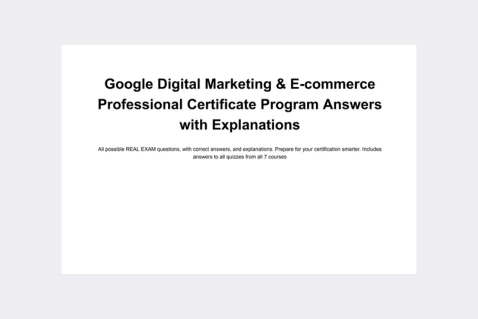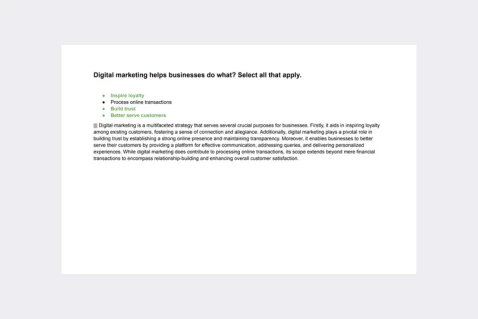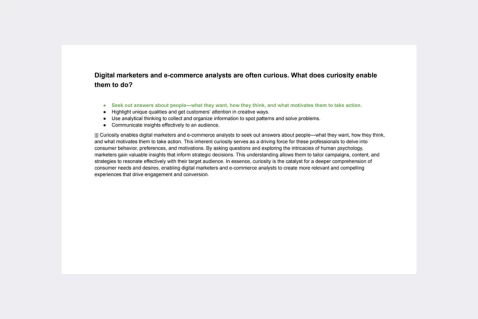As a digital marketer, you work on elements of the product page and checkout process that speed up the page load time. This strategy falls under which marketing funnel stage?
Consideration
Loyalty
Awareness
Conversion
Certification program: 👉 Google Digital Marketing & E-commerce Professional Certificate (Coursera)
Explanation: The strategy of working on elements of the product page and checkout process to speed up the page load time falls under the Conversion stage of the marketing funnel. In this stage, the focus is on turning potential customers into actual buyers by streamlining the path to purchase and reducing any barriers or friction in the buying process. Optimizing the website’s performance, including faster page load times, contributes to a smoother and more efficient user experience, increasing the likelihood of conversion. Unlike awareness, consideration, or loyalty, the conversion stage is specifically centered around prompting the audience to take the desired action of making a purchase.
Passing exams is not a workout. Multiple attempts won’t make you stronger.



- All possible certificate program questions
- Real certification exam questions
- Detailed answer explanations.
- Over 1700 questions, 7 courses, 30 quizzes
- Free lifetime updates.
Accelerating Page Load Time: Enhancing User Experience and Conversion Rates
In the realm of digital marketing, optimizing the performance of your website is crucial for providing users with a seamless and satisfying experience. One key aspect of website optimization is speeding up the page load time, which can have a significant impact on user engagement, satisfaction, and conversion rates. But where does optimizing page load time fit into the marketing funnel, and how can digital marketers leverage it to their advantage? Let’s delve into this topic and explore some practical insights for enhancing user experience and driving conversions through faster page load times.
Understanding the Marketing Funnel
The marketing funnel represents the stages that a potential customer goes through before making a purchase. These stages typically include:
- Awareness: Customers become aware of your brand, product, or service.
- Interest: Customers express interest in your offerings and seek more information.
- Consideration: Customers evaluate your offerings and compare them to alternatives.
- Conversion: Customers make a purchase or complete a desired action.
- Retention: Customers become repeat buyers and advocate for your brand.
The Role of Page Load Time Optimization
Optimizing page load time primarily aligns with the consideration and conversion stages of the marketing funnel. At these stages, potential customers are actively engaging with your website, evaluating your offerings, and considering making a purchase. By ensuring fast and responsive page load times, digital marketers can enhance user experience, reduce bounce rates, and increase the likelihood of users completing desired actions, such as making a purchase or signing up for a newsletter.
Practical Insights for Page Load Time Optimization
To effectively optimize page load time and enhance user experience, consider the following practical insights:
-
Optimize Images and Media: Compress images and optimize media files to reduce their file size without sacrificing quality. Use image compression tools and formats such as WebP to ensure fast loading times while maintaining visual appeal.
-
Minimize HTTP Requests: Reduce the number of HTTP requests by combining and minifying CSS and JavaScript files. Limit the use of external scripts and plugins that may increase page load times and prioritize essential resources for faster rendering.
-
Enable Browser Caching: Leverage browser caching to store static resources locally on users’ devices, reducing the need for repeated downloads and speeding up subsequent page loads. Set appropriate expiration dates for cached assets to ensure freshness and efficiency.
-
Implement Content Delivery Networks (CDNs): Utilize CDNs to distribute website content across multiple servers and locations worldwide. CDNs help minimize latency and improve loading times by serving content from the nearest server to the user’s location, enhancing overall performance and responsiveness.
-
Prioritize Critical Content: Implement lazy loading techniques to defer the loading of non-essential content, such as images and videos, until users scroll down the page. Prioritize loading critical content above the fold to ensure a fast and engaging initial experience for users.
Driving Conversions with Faster Page Load Times
In conclusion, optimizing page load time is a critical aspect of website optimization that directly impacts user experience and conversion rates. By prioritizing fast and responsive page loading times, digital marketers can enhance user satisfaction, reduce bounce rates, and increase the likelihood of users completing desired actions, ultimately driving conversions and achieving business objectives.
Remember, in the competitive landscape of digital marketing, every second counts. So, prioritize page load time optimization as part of your broader website optimization strategy and reap the benefits of improved user experience and conversion rates.
Discover our best-value guides
- Special Bundle Offer Google_Ads_Roll
- Special Bundle Offer HubSpot_Exams_Roll
- Special Offer Unchained_Guru_Roll
- Special Bundle Offer Amazon_Roll
- Special Bundle Offer Google_Analytics_Roll
- Special Bundle Offer Google_SkillShop_Roll
- Special Bundle Offer Marketing_Platforms_Roll
- Special Bundle Offer Microsoft_Advertising_Roll
- Special Bundle Offer YouTube_Roll
- Special Bundle Offer Google_Android_Roll
- Ultimate PMP certification preperation guide
- Google Cloud Professional Architect Certification Exam Answers - Ultimate Guide
- Special Bundle Offer SEMrush_Roll